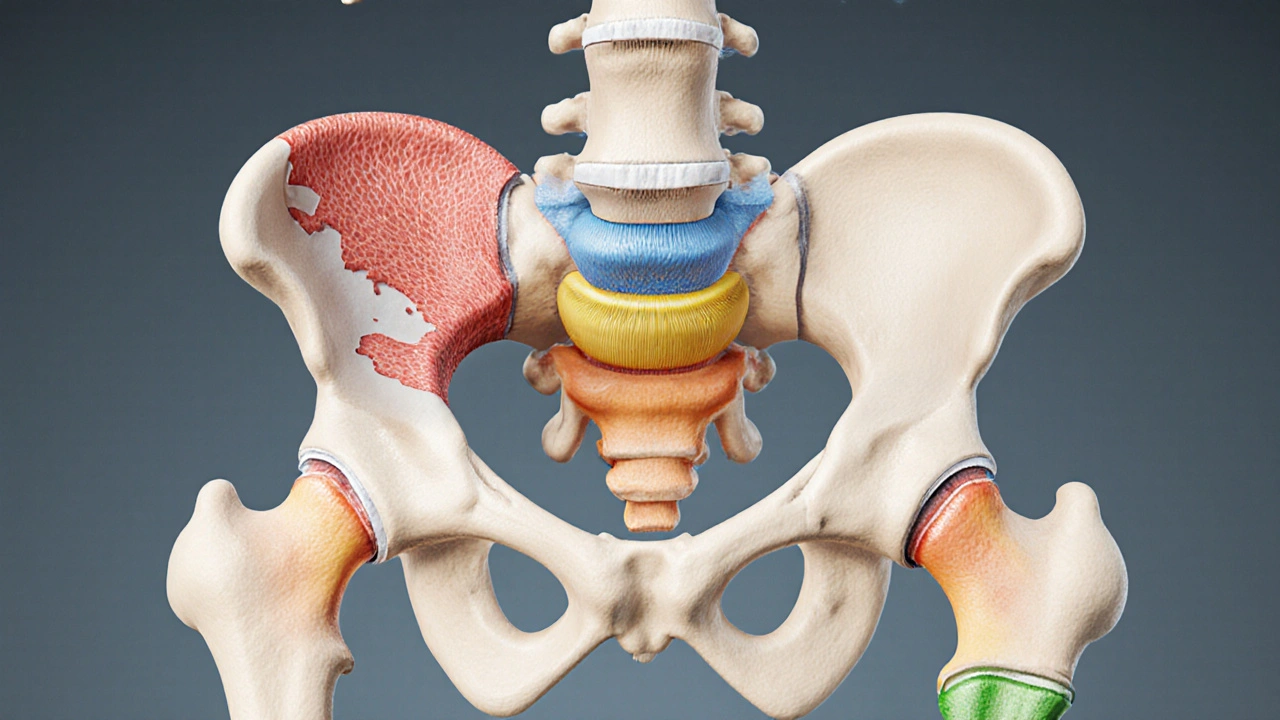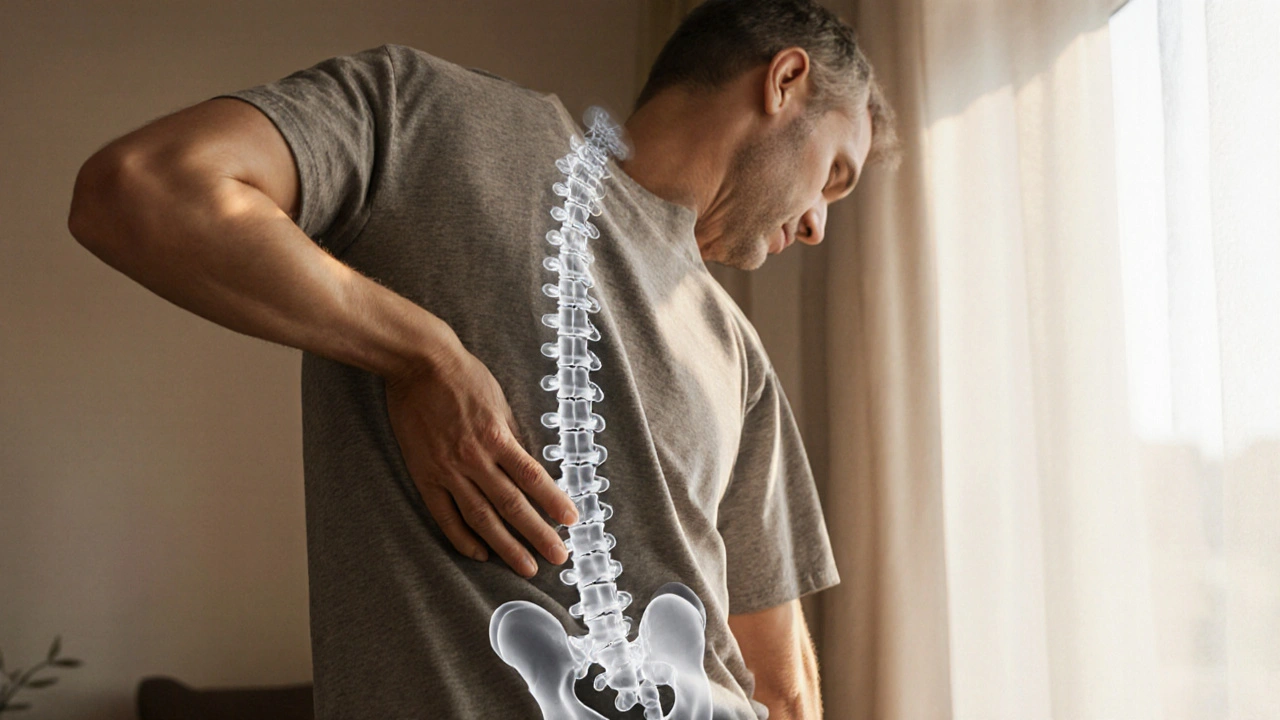Lower Back Pain Symptom Assessment Tool
Understanding Your Symptoms
This tool provides general information about bone-related causes of lower back pain based on your symptoms. It is not a medical diagnosis. Always consult a healthcare professional for proper evaluation.
Key Takeaways
- Bone damage-like fractures, osteoporosis, or joint degeneration-often shows up as lower back pain.
- Understanding the specific bone issue helps choose the right imaging and treatment.
- Early diagnosis through bone density scans or MRI can prevent chronic problems.
- Targeted exercises, proper nutrition, and posture support long‑term spine health.
- When pain is sudden, severe, or accompanied by numbness, seek medical care promptly.
When Bone Damage is any injury or deterioration that compromises the structure of a bone, such as a fracture, osteoporosis, or degenerative change, it often presents as lower back pain. The spine is a stack of bones (vertebrae) that protect the spinal cord and support the torso. If any part of that stack gets weakened or broken, the surrounding muscles, ligaments, and nerves react with pain signals. Below we’ll unpack the most common bone‑related culprits, how doctors pinpoint the cause, and what you can do to ease the ache and keep your back strong.
What "Bone Damage" Actually Means
Bone isn’t a static solid; it constantly remodels, breaking down old tissue and building new. Damage can happen in two broad ways:
- Traumatic injury - a sudden impact that cracks or shatters a vertebra.
- Degenerative loss - slow weakening over years, often due to age, hormonal changes, or lifestyle.
Both pathways can lead to the same symptom: a nagging or sharp ache in the lower back region. Knowing which pathway is at play dictates the next steps-whether a cast, a bone‑strengthening medication, or a physiotherapy program.

How Different Bone Issues Trigger Lower Back Pain
Below are the top bone‑related conditions that frequently manifest as lower back pain. Each paragraph introduces the condition with its own micro‑data definition, followed by the typical pain pattern and why it matters.
Osteoporosis is a systemic disease that reduces bone mineral density, making bones porous and prone to fracture. In the spine, the tiny trabecular bone inside each vertebra thins out, so even a minor tumble or a simple lift can cause a compression fracture. The pain usually feels like a dull, constant ache that worsens when you stand or bend forward.
Vertebral Fracture is a break in one of the spinal bones, often resulting from osteoporosis, trauma, or metastatic disease. Unlike muscle strains, a fracture can change the shape of the spine, leading to a noticeable hunched posture (kyphosis). The pain spikes with movements that load the affected vertebra-think coughing, sneezing, or lifting a heavy bag.
Degenerative Disc Disease is the gradual loss of disc height and elasticity due to wear and tear, which reduces shock absorption between vertebrae. When discs shrink, the neighboring bones may rub together, irritating the facet joints and surrounding nerves. Pain often radiates from the low back down the buttocks and sometimes into the thighs, especially after prolonged sitting.
Sacroiliac Joint Dysfunction is a condition where the sacroiliac joint (where the sacrum meets the pelvis) becomes overly stiff or too lax, causing abnormal movement. The joint sits just below the lumbar spine, so a malfunction can mimic lumbar pain. Patients describe a deep, aching sensation that worsens when standing on one leg or climbing stairs.
Spinal Arthritis is an inflammatory or degenerative process affecting the facet joints and surrounding bone, often called facet joint arthropathy. Arthritis narrows the joint space, leading to bone spurs that pinch nerves. The hallmark is stiffness in the morning that eases after a few minutes of movement, followed by a sharp pain during twisting.
Diagnosing the Source of Bone‑Related Back Pain
Because many bone conditions share similar pain sensations, imaging and specific tests become essential. Below are the two most common tools, again introduced with micro‑data markup.
Bone Density Test (DXA) is a dual‑energy X‑ray absorptiometry scan that measures bone mineral content, helping detect osteoporosis early. The test takes just a few minutes, involves minimal radiation, and provides a T‑score that tells you how your bone health compares to a healthy young adult.
MRI Scan is a magnetic resonance imaging procedure that visualizes soft tissue, bone marrow, and disc integrity without radiation. MRI is the gold standard for spotting occult vertebral fractures, disc degeneration, and nerve compression. It’s especially useful when X‑rays appear normal but pain persists.
In many cases, a simple X‑ray will catch a clear fracture, while more subtle conditions like sacroiliac dysfunction may require a combination of CT, bone scan, or diagnostic injections.
Treatment Paths-From Pain Relief to Long‑Term Healing
Once the specific bone issue is identified, treatment can be grouped into three tiers: immediate pain control, targeted healing, and lifestyle support.
- Medication - NSAIDs for inflammation, short‑course opioids for severe breakthrough pain, and bisphosphonates or denosumab for osteoporosis.
- Physical Therapy - core‑strengthening exercises, lumbar stabilization drills, and manual therapy to improve alignment and reduce stress on damaged bone.
- Interventional Procedures - vertebroplasty or kyphoplasty for compression fractures, facet joint injections for arthritis, and sacroiliac joint blocks for dysfunction.
- Surgical Options - spinal fusion or decompression when bone spurs compress nerves or when vertebral collapse threatens stability.
Most patients find relief with a combination of medication and a well‑designed physiotherapy program. The key is to avoid activities that overload the injured bone while gradually re‑introducing safe movement.

Everyday Prevention-Keeping Your Spine Strong
Preventing bone‑related back pain isn’t about avoiding exercise; it’s about choosing the right moves and nutrients.
- Calcium & Vitamin D - Aim for 1,200mg of calcium and 800‑1,000IU of vitamin D daily. Dairy, leafy greens, fortified plant milks, and safe sun exposure are simple sources.
- Weight‑Bearing Activities - Walking, light jogging, or resistance training stimulate bone remodeling. Start with 30 minutes, three times a week, and progress as comfort allows.
- Core Stability - Planks, bird‑dogs, and pelvic tilts support the lumbar spine, reducing the load on vertebrae during daily tasks.
- Posture Awareness - Ergonomic chairs, standing desks, and a mindful habit of keeping ears over shoulders can prevent excessive compression of the lower back.
- Regular Screening - If you’re over 50 or have risk factors (family history, smoking, steroid use), schedule a DXA scan every two years.
By integrating these habits, you give your bones the minerals and mechanical signals they need to stay dense and resilient.
Quick Comparison of Common Bone‑Related Back Pain Sources
| Condition | Typical Pain Pattern | Preferred Diagnostic Test | First‑Line Treatment |
|---|---|---|---|
| Osteoporosis‑related fracture | Dull ache worsened by standing; possible height loss | X‑ray + DXA | Pain meds + vertebroplasty if unstable |
| Degenerative disc disease | Sharp pain after sitting; radiates to buttocks | MRI | Physical therapy + NSAIDs |
| Sacroiliac joint dysfunction | Deep ache on one side, worse when weight‑bearing on one leg | CT or sacroiliac injection test | Joint stabilisation exercises + injections |
| Spinal arthritis (facet joint) | Stiffness in the morning, sharp pain on twisting | CT or facet joint block | NSAIDs + facet joint injection |
Frequently Asked Questions
Can a mild bone bruise cause chronic lower back pain?
Yes. A bone bruise (micro‑fracture) may not show on plain X‑ray but can inflame surrounding tissue. MRI can reveal marrow edema, and rest combined with anti‑inflammatory medication often resolves the pain within weeks.
How fast does an osteoporosis‑related fracture heal?
Healing can take 8‑12 weeks, but pain relief may occur sooner with vertebroplasty or bracing. Adequate calcium, vitamin D, and weight‑bearing exercise speed up bone remodeling.
Is surgery ever needed for a simple vertebral compression fracture?
Most minor fractures heal with conservative care (pain meds, activity modification). Surgery-usually kyphoplasty-is reserved for fractures that cause severe deformity, progressive height loss, or persistent nerve irritation.
Can a DXA scan miss early bone loss?
DXA is highly sensitive for detecting osteoporosis, but it measures the lumbar spine and hip only. Early cortical thinning in the vertebrae may be better seen on high‑resolution peripheral QCT. Discuss with your doctor if risk factors are high.
What everyday activities should I avoid with a recent vertebral fracture?
Avoid heavy lifting, repetitive bending, and high‑impact sports for at least 6 weeks. Gentle walking, swimming, and prescribed core exercises are usually safe and promote healing.

